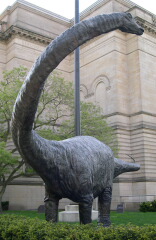This article is currently slated for merging. There is consensus to merge Dippy (London) into this article. You can carry out the merge by following the resolution at the discussion and the merging instructions. Process started May 2025. |
 | |
| Catalog no. | CM 84 |
|---|---|
| Common name | Dippy |
| Species | Diplodocus carnegii |
| Age | c. 150 million years [1] |
| Place discovered | Sheep Creek Quarry D, near Medicine Bow, Wyoming; upper 10 m (33 ft) of the Talking Rock facies of the Brushy Basin Member of the Morrison Formation |
| Date discovered | July 4, 1899 |
| Discovered by | William Harlow Reed |
Dippy is a composite Diplodocus skeleton in Pittsburgh's Carnegie Museum of Natural History, and the holotype of the species Diplodocus carnegii. It is considered the most famous single dinosaur skeleton in the world, due to the numerous plaster casts donated by Andrew Carnegie to several major museums around the world at the beginning of the 20th century. [2] [3]
Contents
- Discovery
- Pittsburgh display
- Casts
- Background
- London cast
- Other casts
- Pittsburgh statue
- Gallery
- See also
- References
- Bibliography
- Editio princeps
- Secondary sources
- Further reading
- External links
The casting and distribution of the skeleton made the word dinosaur a household word; [4] for millions of people it became the first dinosaur they had ever seen. [5] It was also responsible for the subsequent popularity of the entire genus Diplodocus, since the skeleton has been on display in more places than any other sauropod dinosaur. [6]
Its discovery was catalyzed by the announcement of the excavation of a large thigh bone (unrelated to Dippy) by William Reed near Medicine Bow, Wyoming in December 1898. [7] On a return trip financed by Carnegie, Reed excavated Sheep Creek Quarry D in which he found the first part of Dippy's skeleton, a toe bone, on July 4, 1899. [8] Its discovery on Independence Day, and its use in American diplomacy via Carnegie's international donations of replicas, led to its being nicknamed the "star-spangled dinosaur". [9] Dippy became the centrepiece of the Carnegie Museum of Natural History, such that the museum became known as "the house that Dippy built". [4] [10]
In 2016, a petition to the International Commission on Zoological Nomenclature was being considered which proposed to make Diplodocus carnegii the new type species of Diplodocus. [11] The proposal was rejected in 2018, and D. longus has been maintained as the type species. [11] [12]




















